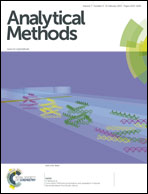Determination of formaldehyde residue in cosmetics by short-column high performance liquid chromatography with mass spectrometric confirmation†
Abstract
In this work, we report a rapid analytical method for the determination of trace formaldehyde in cosmetics on a 12.5 mm C18 guard column. The shortest time (0.5 min) was obtained for one separation with 1.5 mL min−1 of methanol–water 50 : 50 (v/v) as the mobile phase at a column temperature of 30 °C. A linear response between peak area and the concentration of formaldehyde was obtained over the range 0.1 to 20 mg L−1 with a relative standard deviation of 1.4% (n = 10) at the concentration of 1.0 mg L−1 and a detection limit of 5.1 μg L−1. The confirmation assay by liquid chromatography tandem mass spectrometry indicated that there was no interfering effect from other carbonyl compounds. The proposed method was applied for the determination of formaldehyde residue in cosmetics at the mg L−1 level. Free formaldehyde up to 27 mg kg−1 was found in cosmetics and the spike recovery at the spiked levels of 1.0 and 10.0 mg L−1 varying from 92% to 105% was also obtained. The difference between the values determined by the proposed method and the standard spectrophotometric method was below 3.7%. The results proved the accuracy and precision of the method, showing potential for the routine analysis of formaldehyde residue.


 Please wait while we load your content...
Please wait while we load your content...